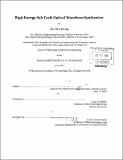| dc.contributor.advisor | Franz X. Kärtner. | en_US |
| dc.contributor.author | Huang, Shu-Wei, Ph. D. Massachusetts Institute of Technology | en_US |
| dc.contributor.other | Massachusetts Institute of Technology. Dept. of Electrical Engineering and Computer Science. | en_US |
| dc.date.accessioned | 2012-12-13T18:47:52Z | |
| dc.date.available | 2012-12-13T18:47:52Z | |
| dc.date.copyright | 2012 | en_US |
| dc.date.issued | 2012 | en_US |
| dc.identifier.uri | http://hdl.handle.net/1721.1/75634 | |
| dc.description | Thesis (Ph. D.)--Massachusetts Institute of Technology, Dept. of Electrical Engineering and Computer Science, 2012. | en_US |
| dc.description | Cataloged from PDF version of thesis. | en_US |
| dc.description | Includes bibliographical references (p. 147-157). | en_US |
| dc.description.abstract | Over the last decade, the control of atomic-scale electronic motion by optical fields strong enough to mitigate the atomic Coulomb potential, has broken tremendous new ground with the advent of phase controlled high-energy few-cycle pulse sources. In particular, broadband optical parametric chirped pulse amplifier (OPCPA) has been investigated intensively in recent years to enable studies of novel strong-field physics phenomena such as high-harmonic generation (HHG) and strong-field ionization. Further investigation and control of these physical processes ask for the capability of waveform shaping on sub-cycle time scales, which requires a fully phase-controlled multiple-octave-spanning spectrum. To date, no single laser source can support a bandwidth of more than an octave. Coherent synthesis of pulses with different spectra, or wavelength multiplexing, presents a route towards obtaining a multi-octave spanning laser spectrum. The benefit of this approach lies in its modular design and scalability in both bandwidth and pulse energy. However, it was only recently laser scientists were able to successfully demonstrate coherent synthesis of two lasers albeit at low energy and high repetition rate. Achieving high pulse energy requires synthesis of low repetition rate pulses, which is a challenge because of the environmental perturbations typifying high-energy amplifiers. The technological advancements towards the ideal source for study and control of such strong-field physics are the focus of this thesis. The background reviews on femtosecond Ti:sapphire oscillators, carrier-envelope phase stabilization, chirped pulse amplifier, broadband OPCPAs, and HHG are given in Chapter 1. Chapter 2 starts with a discussion on the various properties of OPCPA which lends itself to the ideal building module for high-energy pulse synthesis. Then it is followed by a comprehensive optimization study and experimental results of broadband OPCPAs at different spectral ranges. In chapter 3, the first high-energy sub-cycle waveform synthesizer is presented. It is the prototype of a class of novel optical tools for atto-second control of strong-field physics experiments. Novel technologies that enable such a waveform synthesizer are described in details. At the end of the chapter, work towards the construction of a large-scale waveform synthesizer is included. Finally, the thesis is concluded by introducing some possible future directions. | en_US |
| dc.description.statementofresponsibility | by Shu-Wei Huang. | en_US |
| dc.format.extent | [v], 157, [2] p. | en_US |
| dc.language.iso | eng | en_US |
| dc.publisher | Massachusetts Institute of Technology | en_US |
| dc.rights | M.I.T. theses are protected by
copyright. They may be viewed from this source for any purpose, but
reproduction or distribution in any format is prohibited without written
permission. See provided URL for inquiries about permission. | en_US |
| dc.rights.uri | http://dspace.mit.edu/handle/1721.1/7582 | en_US |
| dc.subject | Electrical Engineering and Computer Science. | en_US |
| dc.title | High-energy sub-cycle optical waveform synthesizer | en_US |
| dc.type | Thesis | en_US |
| dc.description.degree | Ph.D. | en_US |
| dc.contributor.department | Massachusetts Institute of Technology. Department of Electrical Engineering and Computer Science | |
| dc.identifier.oclc | 818209667 | en_US |
